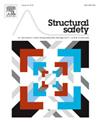多破坏模式下后张混凝土桥面空间时变可靠度分析
IF 6.3
1区 工程技术
Q1 ENGINEERING, CIVIL
引用次数: 0
摘要
现有基础设施的耐久性是结构工程领域的世界性难题。社会对减少温室气体排放的需求,加上许多国家面临的财政限制,促使基础设施管理公司和业主延长现有结构的使用寿命。然而,延长使用寿命会带来一系列与安全性和时间依赖性退化相关的问题。后一个问题对于后张预应力桥面尤其严重,由于使用旧施工技术建造的桥梁观察到的缺陷,这些桥面特别容易退化。为了解决这一问题,我们提出了一种评估后张预应力混凝土桥面整体时变可靠性的方法,这些桥面会受到腐蚀相关退化的影响。提出了一个时间依赖腐蚀过程的模型,该模型结合了基于物理的公式和现有结构的经验证据,考虑了必要的热力学条件和混凝土和灌浆的质量。此外,对每个桥面单元的截面进行了两种破坏模式的评估,即弯曲破坏和剪切破坏。然后计算桥面的时变可靠度,作为一个考虑空间和失效模式依赖关系的系统。将该方法应用于意大利预应力桥梁典型桥面结构的预应力结构的可靠性和技术使用寿命评估,并通过灵敏度分析确定了案例研究的主要输入变量。最后,与结果相关的目标可靠度的比较有助于确定结构的剩余寿命,并为经济高效和可持续的完整性管理提供基础。本文章由计算机程序翻译,如有差异,请以英文原文为准。
Spatial and time-dependent reliability analysis for post-tensioned concrete decks subjected to multiple failure modes
The durability of existing infrastructures is a worldwide challenge in structural engineering. Societal demands for reducing greenhouse gas emissions, coupled with the financial constraints faced by many countries, push infrastructure management companies and owners to extend the lifespan of existing structures. However, extending the lifespan comes with a set of problems related to safety and time-dependent degradation. The latter problem is particularly acute for prestressed bridge decks with post-tensioned tendons, which are especially prone to degradation due to defects observed for bridges built using older construction techniques.
To address this problem, we propose an approach for evaluating the global time-dependent reliability of prestressed concrete bridge decks with post-tensioned tendons, which are subject to corrosion-related degradation. A model for the time-dependent corrosion process is proposed that combines physics-based formulations with empirical evidence from existing structures, accounting for the necessary thermodynamic conditions and the quality of both the concrete and the grout. Furthermore, the sections of each deck element are assessed for two failure modes, namely, bending and shear failure. The time-dependent reliability is then computed for the bridge deck as a system accounting for the spatial and failure mode dependencies. The approach is applied to evaluate the reliability and technical service life of a prestressed structure representing a typical deck configuration for Italian prestressed bridges, and the main input variables for the case study are identified through a sensitivity analysis. Finally, it is demonstrated that the comparison with consequence-related target reliabilities facilitates the determination of a structure's remaining lifespan and provides the basis for economically efficient and sustainable integrity management.
求助全文
通过发布文献求助,成功后即可免费获取论文全文。
去求助
来源期刊

Structural Safety
工程技术-工程:土木
CiteScore
11.30
自引率
8.60%
发文量
67
审稿时长
53 days
期刊介绍:
Structural Safety is an international journal devoted to integrated risk assessment for a wide range of constructed facilities such as buildings, bridges, earth structures, offshore facilities, dams, lifelines and nuclear structural systems. Its purpose is to foster communication about risk and reliability among technical disciplines involved in design and construction, and to enhance the use of risk management in the constructed environment
 求助内容:
求助内容: 应助结果提醒方式:
应助结果提醒方式:


